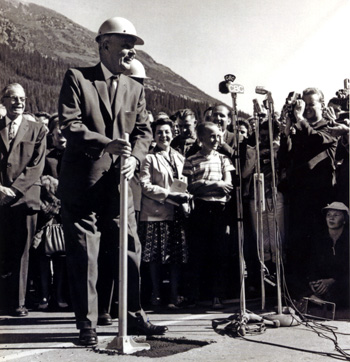Browse "Transportation"
-
Article
Conestoga Wagon
The Conestoga wagon was a large wagon, with broad wheels and a white hemp or canvas cover, used for the transportation of persons and goods across the North American continent prior to the introduction of the railway in the
"https://d2ttikhf7xbzbs.cloudfront.net/media/media/df744b29-90e4-40d3-b6dd-f7f6ec016776.jpg" // resources/views/front/categories/view.blade.php
https://d2ttikhf7xbzbs.cloudfront.net/media/media/df744b29-90e4-40d3-b6dd-f7f6ec016776.jpg
-
Article
CP Rail Crew Bus Crash
On 28 May 1980, 22 workers on a Canadian Pacific Railway steel crew were killed in a bus accident on the Trans-Canada Highway near Webb, Saskatchewan, west of Regina. It was one of the deadliest motor vehicle disasters in Canadian history.
"https://development.thecanadianencyclopedia.ca/images/tce_placeholder.jpg?v=e9dca980c9bdb3aa11e832e7ea94f5d9" // resources/views/front/categories/view.blade.php
https://development.thecanadianencyclopedia.ca/images/tce_placeholder.jpg?v=e9dca980c9bdb3aa11e832e7ea94f5d9
-
Article
CTrain
CTrain is a light rail transit system in Calgary, Alberta. It is operated by Calgary Transit, a public transit service owned by the City of Calgary and operated through its Transportation Department. Service began on the initial downtown transit corridor and south line in 1981. It expanded to northeast Calgary in 1985, to the University of Calgary in the city’s northwest in 1987 and to the city’s west side in 2012. Most of its route and stations are at surface level. Calgary Transit operates the CTrain in conjunction with an extensive network of bus routes. Through equivalency purchases of wind-generated electricity, it has been entirely wind-powered since 2001. Its two separate lines comprise 45 stations, 118.1 km of track, and an average daily ridership of 312,300 (2018).
"https://d2ttikhf7xbzbs.cloudfront.net/media/media/b027d2ab-b82a-4141-b51c-110cf056a16a.jpg" // resources/views/front/categories/view.blade.php
https://d2ttikhf7xbzbs.cloudfront.net/media/media/b027d2ab-b82a-4141-b51c-110cf056a16a.jpg
-
Article
De Havilland Canada DHC-2 Beaver
The de Havilland Canada DHC-2 Beaver, successor to the Noorduyn Norseman, was the all-purpose bush plane of the Canadian North. (See also Bush Flying in Canada.) The Beaver was sturdy, reliable and able to take off and land on short lengths of land, water and snow. It has been called the best bush plane ever built. While de Havilland Canada produced it for only 20 years — from 1947 to 1967 — many Beaver planes still fly today. The Beaver helped connect communities in remote areas of Canada, in addition to serving across the globe.
"https://d2ttikhf7xbzbs.cloudfront.net/media/media/89a6de54-a002-4422-ae1b-9afcba170499.jpg" // resources/views/front/categories/view.blade.php
https://d2ttikhf7xbzbs.cloudfront.net/media/media/89a6de54-a002-4422-ae1b-9afcba170499.jpg
-
Article
de Havilland Caribou
De Havilland Caribou, DHC-4, twin-engined STOL aircraft capable of taking off in only 220 m. It was characterized by the sharp upward angle of the rear fuselage, providing access for large loads. It first flew July 1958, and was used mostly in a military role.
"https://development.thecanadianencyclopedia.ca/images/tce_placeholder.jpg?v=e9dca980c9bdb3aa11e832e7ea94f5d9" // resources/views/front/categories/view.blade.php
https://development.thecanadianencyclopedia.ca/images/tce_placeholder.jpg?v=e9dca980c9bdb3aa11e832e7ea94f5d9
-
Article
de Havilland Dash 7
De Havilland Dash 7, DHC-7, STOL aircraft designed for efficient transport from city centres. It first flew March 1975 after a long development costing $120 million, four-fifths of which was paid by the federal government. Its
"https://development.thecanadianencyclopedia.ca/images/tce_placeholder.jpg?v=e9dca980c9bdb3aa11e832e7ea94f5d9" // resources/views/front/categories/view.blade.php
https://development.thecanadianencyclopedia.ca/images/tce_placeholder.jpg?v=e9dca980c9bdb3aa11e832e7ea94f5d9
-
Article
de Havilland Otter
By the mid-1950s de Havilland realized the need for a larger, more powerful version of the DHC-3.
"https://d2ttikhf7xbzbs.cloudfront.net/media/media/14a5d16a-7b35-4813-9e3d-53e3c7a19009.jpg" // resources/views/front/categories/view.blade.php
https://d2ttikhf7xbzbs.cloudfront.net/media/media/14a5d16a-7b35-4813-9e3d-53e3c7a19009.jpg
-
Article
Deep Rover
A one-man submersible capable of working 4-6 hours under water to a depth of 914 m at speeds up to 1.5 knots, Deep Rover was designed by Graham Hawkes at San Leandro, Calif, and built by Can-Dive Services Ltd of Vancouver and in Dartmouth, NS, in 1984 to work in the offshore oil industry.
"https://development.thecanadianencyclopedia.ca/images/tce_placeholder.jpg?v=e9dca980c9bdb3aa11e832e7ea94f5d9" // resources/views/front/categories/view.blade.php
https://development.thecanadianencyclopedia.ca/images/tce_placeholder.jpg?v=e9dca980c9bdb3aa11e832e7ea94f5d9
-
Article
Dorion School Bus–Train Crash
A collision between a school bus and a freight train on 7 October 1966 killed 19 students from Cité-des-Jeunes secondary school near Vaudreuil, Quebec, and their bus driver. The crash is among the worst road disasters in Canadian history.
"https://development.thecanadianencyclopedia.ca/images/tce_placeholder.jpg?v=e9dca980c9bdb3aa11e832e7ea94f5d9" // resources/views/front/categories/view.blade.php
https://development.thecanadianencyclopedia.ca/images/tce_placeholder.jpg?v=e9dca980c9bdb3aa11e832e7ea94f5d9
-
Article
Dugout Canoe
A dugout canoe was a common type of canoe, traditionally used by Indigenous peoples and early settlers wherever the size of tree growth made construction possible. The dugout canoe was most popular along the West Coast, where waters teeming with sea life—whales, seals, sea lions, salmon, halibut, herring, eulachon and shellfish—sustained a complex maritime culture. (See also Northwest Coast Indigenous Peoples in Canada.)
"https://d2ttikhf7xbzbs.cloudfront.net/media/media/bf947505-9d11-4814-8e02-371873d5aa8c.jpg" // resources/views/front/categories/view.blade.php
https://d2ttikhf7xbzbs.cloudfront.net/media/media/bf947505-9d11-4814-8e02-371873d5aa8c.jpg
-
Article
Eastman Bus Crash
Canada’s second deadliest road disaster was a single-vehicle bus crash that killed 40 people near Eastman, Quebec on 4 August 1978.
"https://development.thecanadianencyclopedia.ca/images/tce_placeholder.jpg?v=e9dca980c9bdb3aa11e832e7ea94f5d9" // resources/views/front/categories/view.blade.php
https://development.thecanadianencyclopedia.ca/images/tce_placeholder.jpg?v=e9dca980c9bdb3aa11e832e7ea94f5d9
-
Macleans
Electric Cars to be Marketed
This article was originally published in Maclean’s magazine on July 29, 1996. Partner content is not updated. O'Callaghan was one of the first people in Canada to drive the Impact, a compact electric vehicle (known as an EV) that will soon be the subject of a joint research project by General Motors Corp., B.C. Hydro and the British Columbia government.
"https://d2ttikhf7xbzbs.cloudfront.net/media/media/7024f0cf-140f-4776-9c23-55385216584a.jpg" // resources/views/front/categories/view.blade.php
https://d2ttikhf7xbzbs.cloudfront.net/media/media/7024f0cf-140f-4776-9c23-55385216584a.jpg
-
Article
Empress of Ireland
Empress of Ireland, Canadian Pacific oceangoing passenger ship that sank in the St Lawrence River near Rimouski, Québec, 29 May 1914. She was rammed in dense fog by the Norwegian collier Storstad and sank in only 14
"https://d2ttikhf7xbzbs.cloudfront.net/media/media/6b656b4b-173d-416d-967d-03c44bca61ca.jpg" // resources/views/front/categories/view.blade.php
https://d2ttikhf7xbzbs.cloudfront.net/media/media/6b656b4b-173d-416d-967d-03c44bca61ca.jpg
-
Editorial
Far Out on the Left Coast: British Columbia's Sense of Isolation and Belonging
The following article is an editorial written by The Canadian Encyclopedia staff. Editorials are not usually updated.
"https://d2ttikhf7xbzbs.cloudfront.net/media/media/7b06d87e-9726-4b65-b3c8-96f77dd85c63.jpg" // resources/views/front/categories/view.blade.php
https://d2ttikhf7xbzbs.cloudfront.net/media/media/7b06d87e-9726-4b65-b3c8-96f77dd85c63.jpg
-
Article
Ferries
Although the Scandinavians claim to have pioneered the RO-RO concept, the first purpose-built RO-RO ferry was the Motor Princess, launched at Esquimalt, BC, in 1923 for Canadian Pacific. It ended its long career with British Columbia Ferry Corporation in the 1970s as the Pender Queen.
"https://d2ttikhf7xbzbs.cloudfront.net/media/media/95e420bf-19ba-4339-b898-3de73497babb.jpg" // resources/views/front/categories/view.blade.php
https://d2ttikhf7xbzbs.cloudfront.net/media/media/95e420bf-19ba-4339-b898-3de73497babb.jpg
